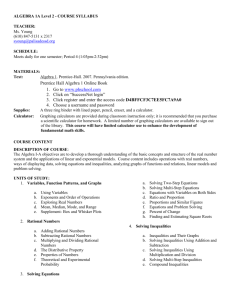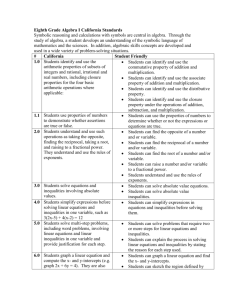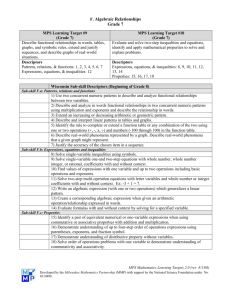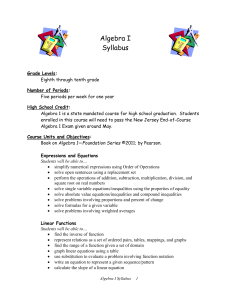Cayahoga Math1200 - geofhagopian.net
advertisement
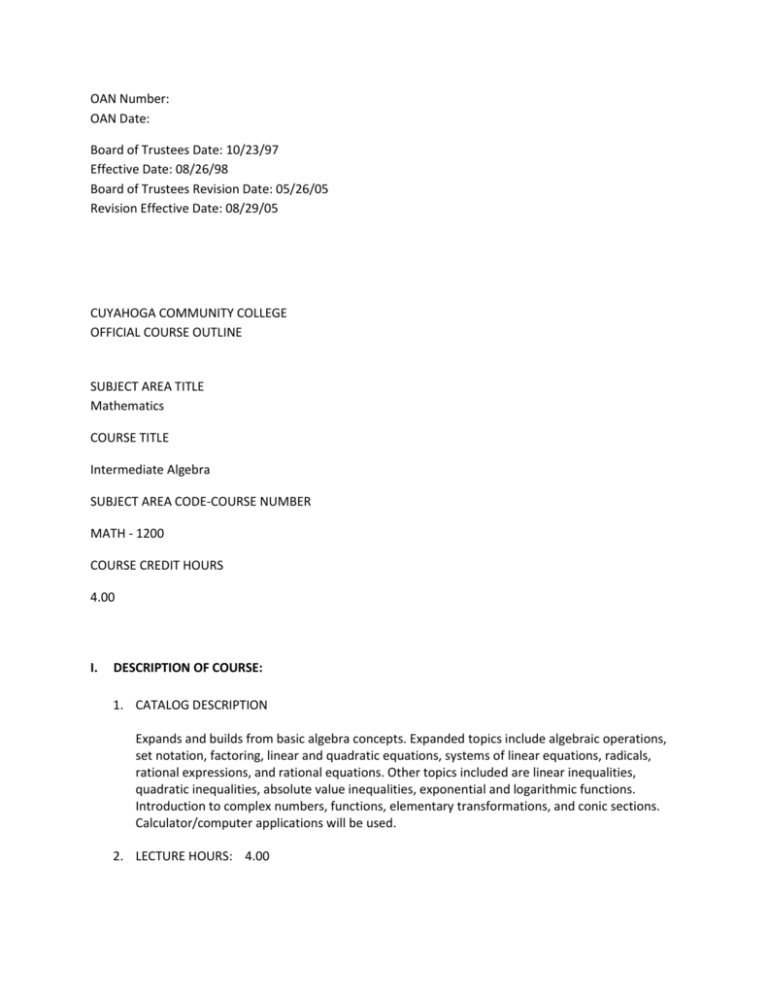
OAN Number: OAN Date: Board of Trustees Date: 10/23/97 Effective Date: 08/26/98 Board of Trustees Revision Date: 05/26/05 Revision Effective Date: 08/29/05 CUYAHOGA COMMUNITY COLLEGE OFFICIAL COURSE OUTLINE SUBJECT AREA TITLE Mathematics COURSE TITLE Intermediate Algebra SUBJECT AREA CODE-COURSE NUMBER MATH - 1200 COURSE CREDIT HOURS 4.00 I. DESCRIPTION OF COURSE: 1. CATALOG DESCRIPTION Expands and builds from basic algebra concepts. Expanded topics include algebraic operations, set notation, factoring, linear and quadratic equations, systems of linear equations, radicals, rational expressions, and rational equations. Other topics included are linear inequalities, quadratic inequalities, absolute value inequalities, exponential and logarithmic functions. Introduction to complex numbers, functions, elementary transformations, and conic sections. Calculator/computer applications will be used. 2. LECTURE HOURS: 4.00 3. LAB HOURS: None 4. OTHER REQUIRED HOURS: 00 5. PREREQUISITE(S): MATH-0960 Beginning Algebra II ; or MATH-0980 Intensified Beginning Algebra ; or sufficient score on assessment test; or departmental approval: equivalent coursework. II. OUTCOMES/OBJECTIVES: Upon satisfactory completion of MATH 1200 - Intermediate Algebra, the student should be able to perform the following outcomes and supporting objectives: A. Express mathematical concepts using sets. 1. Write mathematical concepts using set notation. 2. Identify, evaluate, and write unions and intersections of sets. 3. Write solutions sets in interval notation format. B. Simplify algebraic expressions. 1. Use the laws of exponents to simplify algebraic expressions, including variable exponents. 2. Add, subtract, multiply, and divide polynomials. 3. Add, subtract, multiply, and divide rational expressions. 4. Simplify complex fractions. 5. Evaluate applications involving algebraic expressions. C. Factor expressions. 1. Factor expressions that involve variable exponents. 2. Factor using binomial patterns and other special forms. D. Simplify expressions involving exponents and radicals. 1. Simplify radical expressions, including indices greater than two. 2. Simplify expressions involving rational exponents. 3. Add, subtract, multiply, and divide expressions involving radicals, including indices greater than two. 4. Add, subtract, multiply, and divide complex numbers. 5. Evaluate applications involving exponents and radicals. E. Solve equations and inequalities in one variable of degree greater than or equal to one. 1. Solve compound inequalities. 2. Solve absolute value equations and inequalities. 3. Solve second degree equations. 4. Solve rational equations and inequalities. 5. Use techniques of solving equations and inequalities within applications involving formulas. 6. Solve equations involving radicals. 7. Evaluate applications involving equations and equalities. 8. Graph the solution of inequalities. F. Identify, graph, and evaluate lines and inequalities in two variables. 1. Identify and write equations of lines using standard form, slope-intercept form, and point-slope form. 2. Graph solutions of linear equations. 3. Graph solutions of linear inequalities, compound inequalities, and absolute value inequalities. 4. Evaluate applications involving lines and inequalities in two variables. G. Determine the solution set of systems of linear and quadratic equations algebraically and graphically. 1. Graph the solution of a system of equations in two variables. 2. Solve linear system of equations in three variables using the method of substitution. 3. Solve linear system of equations in three variables using the method of elimination. H. Use the definition, properties, and distinguishing characteristics of functions. 1. Evaluate a function and determine its range and domain. 2. Add, subtract, multiply, divide, and determine composites of functions. 3. Graph special functions such as absolute value functions and square root functions. 4. Graph elementary transformations of functions. 5. Define and determine the inverse of functions. 6. Identify and evaluate direct, inverse, and joint variations. I. Analyze exponential and logarithmic functions and equations. 1. Define and graph exponential and logarithmic functions. 2. Identify properties of logarithmic functions and use the properties to simplify logarithmic expressions. 3. Define and evaluate common logarithms. 4. Define and evaluate natural logarithms. 5. Use the inverse relationship between the exponential function and logarithmic function to solve exponential and logarithmic equations. 6. Evaluate applications involving exponential and logarithmic functions and equations. J. Identify graphs and equations of conic sections (circles, parabolas, ellipses, and hyperbolas). 1. Determine the center and radius of circles and graph circles. 2. Determine the vertex of parabolas and graph parabolas. 3. Identify equations of ellipses and hyperbolas centered at the origin and graph them. 4. Solve a system of two nonlinear equations using the methods of substitution and/or elimination. 5. Graph second degree inequalities. 6. Graph solutions of systems of second degree inequalities. K. Demonstrate calculator/computer awareness. 1. Evaluate functions using a calculator/computer. 2. Graph functions using a calculator/computer. 3. Solve equations using a calculator/computer. 4. Solve a system of equations using a calculator/computer. III. COURSE CONTENT: A. Sets 1. Notation 2. Union and intersection 3. Interval notation B. Algebraic expressions C. D. E. F. G. H. I. 1. Laws of exponents including variable exponents 2. Operations with polynomials 3. Operations with rational expressions 4. Complex fractions Factoring techniques 1. Variable exponent expressions 2. Special forms Exponents and radicals 1. Radicals 2. Rational exponents 3. Operations with radicals 4. Complex numbers 5. Applications Equations and inequalities in one variable 1. Inequalities and compound inequalities 2. Absolute value equations and inequalities 3. Second degree equations 4. Rational equations and inequalities 5. Formulas 6. Equations involving radicals 7. Graphing solutions sets 8. Applications Lines and linear inequalities in two variables 1. Equations of straight line a. Standard form b. Slope-intercept form c. Point-slope form 2. Graphs of linear equations 3. Graphic solution of linear inequalities, compound inequalities, and absolute value inequalities 4. Applications System of linear equations in two and three variables 1. Graphing method for two variables 2. Substitution method 3. Elimination method Functions 1. Definition and notation 2. Operations on functions 3. Elementary transformations of graphs 4. Special functions such as the absolute value function and square root functions 5. Inverses 6. Variation Exponential and logarithmic functions 1. Definitions and graphs 2. Properties of logarithmic functions 3. Common logarithms 4. Natural logarithms 5. Exponential and logarithmic equations 6. Applications Conic sections 1. Circle 2. Parabola 3. Ellipses and hyperbolas centered at the origin 4. Systems of nonlinear equations 5. Graphic solutions of second degree inequalities 6. Graph systems of second degree inequalities K. Calculator/computer awareness 1. Evaluation of functions 2. Graphs of functions 3. Solution of equations 4. Solution of a system of equations J. IV. METHODS OF STUDENT EVALUATION MAY INCLUDE ANY OF THE FOLLOWING: A. B. C. D. E. F. Periodic exams Homework Quizzes In class collaborative work Graphing calculator/computer assignments Comprehensive final exam V. RESOURCES MAY INCLUDE ANY OF THE FOLLOWING: A. Bittinger, Marlin L. Intermediate Algebra: Alternative Version. 8th ed. Reading, MA: Addison Wesley Longman, Inc., 1999. B. Bittinger, Marlin L. and David J. Ellenbogen . Intermediate Algebra: Concepts and Applications. 6th ed. Boston, MA: Addison Wesley Longman, Inc., 2002. C. Dugopolski, Mark. Intermediate Algebra. 4th ed. New York, NY: McGraw-Hill Companies, Inc., 2004. D. Hall, James and Brian A. Mercer. Beginning and Intermediate Algebra: The Language and Symbolism of Mathematics. 1st ed. New York, NY: McGraw-Hill Companies, Inc., 2003. E. Kinney, D. Patrick and Douglas F. Robertson. Intermediate Algebra Personal Academic Notebook. Bloomington, MN: PLATO Learning, Inc., 2004. F. Lial, Margaret L., John E. Hornsby, and Terry McGinnis. Introductory and Intermediate Algebra. 2nd ed. Boston, MA: Addison Wesley Longman, Inc., 2002. VI. ADDITIONAL RESOURCES: A. Software provided by the publisher.

